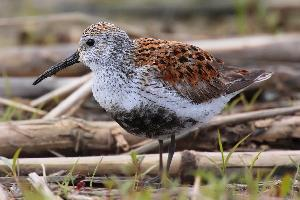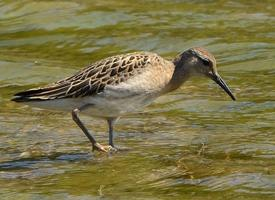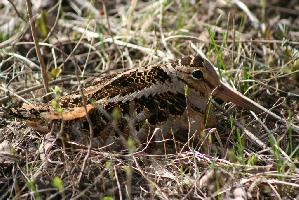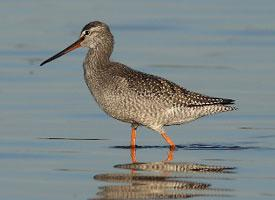
Description de l'animal
The Dunlin (Calidris alpina) is a small, charismatic wader that graces many of the world's shorelines, mudflats, and estuaries. This bird is a member of the sandpiper family, Scolopacidae, and is known for its distinctive seasonal plumage, migratory habits, and dynamic feeding techniques. With a widespread distribution, the Dunlin is a familiar sight across the Northern Hemisphere, including parts of Europe, Asia, and North America.Physical Description:
The Dunlin is a medium-sized sandpiper, typically measuring about 17-21 cm in length, with a wingspan of around 32-36 cm, and weighing between 40-60 grams. One of its most notable features is its bill, which is relatively long, slightly down-curved, and well adapted to probing mud and sand for prey. Its legs are relatively short and black in color, which, when combined with its bill, gives it a distinctive silhouette.
In the breeding season, the Dunlin sports a beautiful reddish-brown back and a distinctive black belly patch, which makes it easily identifiable. The head and breast are also tinged with the same reddish hue, contrasting sharply with its bright white underparts. During the winter months, the Dunlin undergoes a transformation, with its plumage becoming more subdued; the rich tones are replaced by mottled gray on its upper parts and a clean white below, allowing it to blend seamlessly with the winter landscapes of its migratory destinations.
Behavior and Ecology:
Dunlins are highly gregarious birds, often found in large flocks that can number in the thousands during migration and winter. They exhibit a fascinating array of feeding behaviors, including probing and pecking at the ground in search of invertebrates, and can often be seen running back and forth with the tide, dodging waves while they feed.
Their diet consists mainly of insects, small crustaceans, and mollusks, which they skillfully extract from mud and sand with their sensitive bills. This diet varies depending on the season and the availability of food sources in their environment.
Migration is a critical part of the Dunlin's life cycle. Breeding mainly in Arctic and sub-Arctic regions, they migrate southward in the winter to escape the harsh conditions, traveling to coastal areas in temperate and subtropical regions. This remarkable journey is a testament to their endurance and adaptability.
Reproduction:
The breeding season for Dunlins begins in late spring and early summer. They are ground-nesters, choosing sites in the tundra or other open, wet environments. The female lays a clutch of 3-4 eggs, which are incubated by both parents for about 21-22 days. The chicks are precocial, meaning they are relatively mature and mobile from the moment of hatching. They are cared for by both parents but quickly develop the ability to feed themselves.
Conservation Status:
The Dunlin is classified as Least Concern by the International Union for Conservation of Nature (IUCN), reflecting its wide distribution and large population size. However, like many migratory species, it faces threats from habitat loss and degradation, particularly in its wintering and stopover sites. Conservation efforts aimed at preserving wetlands and coastal habitats are vital for ensuring the continued survival of this and many other migratory bird species.
In summary, the Dunlin is a remarkable bird, both for its beauty and its resilience. Its annual migrations are a testament to the incredible journeys undertaken by many bird species across the globe. As it continues to navigate the challenges of a changing world, the Dunlin remains a symbol of the interconnectedness of ecosystems and the importance of global conservation efforts.
Animaux similaires
Nouvelles photos d'animaux
Top 10 des animaux
- Dolphin gull (Leucophaeus scoresbii)
- Diana monkey (Cercopithecus diana)
- Moustached guenon (Cercopithecus cephus)
- Galápagos tortoise (Geochelone nigra complex)
- Stone loach (Barbatula barbatula)
- Japanese macaque (Macaca fuscata)
- Russian tortoise (Testudo horsfieldii)
- Greek tortoise (Testudo graeca)
- Common flying dragon (Draco volans)
- Vendace (Coregonus albula)


